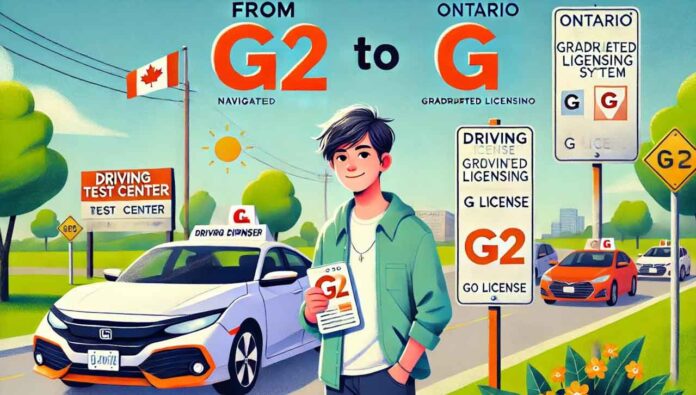Getting from G2 to a full G license in Ontario can feel overwhelming for many new drivers. With the province’s Graduated Licensing System, there are specific steps and requirements to follow.
This post will guide you through this system, offering tips on driver education, preparing for your road test, and understanding driving privileges and restrictions at each stage.
Understanding Ontario’s Graduated Licensing System
Ontario’s Graduated Licensing System comprises various stages, including the G1 and G2 license. Each stage imposes specific requirements and restrictions to ensure road safety and enhance driving experience.
G1 Licence Requirements
To start driving in Ontario, new drivers must first obtain their G1 licence. This initial step requires passing a written knowledge test on road safety and traffic signs. The G1 licence sets the foundation for gaining on-road driving experience under specific conditions.
For instance, G1 drivers must always have a fully licensed driver with over four years of experience in the passenger seat and are not allowed to drive between midnight and 5 AM. Also, maintaining a zero blood alcohol level is mandatory when behind the wheel.
Progressing from G2 to G involves mastering these foundational skills before moving on to more advanced driving situations without supervision. The Ontario graduated licensing system ensures that by the time drivers are ready for their full G licence, they have navigated through various traffic conditions safely and responsibly.
This approach helps prepare them for the complexities of driving independently while prioritizing road safety at every step of their journey from a beginner to an experienced driver.
G2 Licence Requirements
To obtain a G2 license in Ontario, drivers must be at least 16 years old, pass an eye test, and take a written knowledge exam. Additionally, they are required to complete driver education courses and practice driving with a fully licensed driver for at least 12 months before taking the G2 road test.
Holders of the G2 license are permitted to drive without supervision but must adhere to certain conditions such as maintaining a zero blood alcohol level and limiting the number of passengers in the vehicle between midnight and 5 am.
After meeting these requirements, G2 drivers can progress to obtaining their full G license after holding the G2 for at least 12 months. During this time, it is important for drivers to continue practicing safe driving habits and familiarize themselves with all traffic rules and regulations in preparation for taking the road test for their full G license.
Understanding these essential requirements is crucial for new drivers seeking to navigate through Ontario’s graduated licensing system smoothly.
Tips for Navigating the Graduated Licensing System
Navigating Ontario’s Graduated Licensing System requires choosing the right driving school and preparing meticulously for the G2 road test. Taking advantage of available resources is key to avoiding common mistakes and ensuring a smooth transition towards obtaining a full G license.
Choosing the right driving school
When selecting a driving school, look for one that offers comprehensive training programs to prepare for both the G2 road test and the full G license. Ensure the driving school provides qualified instructors who are knowledgeable about Ontario’s graduated licensing system, including important restrictions and rules.
It’s essential to choose a reputable driving school that helps students navigate through the complexities of the G1 and G2 stages, enabling them to develop necessary skills under expert guidance.
Consider enrolling in a driving school that has a proven track record of success in helping students pass their road tests. Look for reviews and testimonials from previous students or seek recommendations from friends and family who have recently obtained their driver’s licenses.
Additionally, make sure the chosen driving school aligns with your schedule, offers flexible hours for lessons, and provides tailored instruction geared towards ensuring your success in obtaining your G license.
Important restrictions and rules to follow
After choosing the right driving school, it’s crucial to understand the important restrictions and rules that come with progressing through Ontario’s graduated licensing system. For G2 drivers, adhering to a zero blood alcohol concentration level is mandatory at all times while behind the wheel.
Additionally, there are passenger restrictions for G2 drivers under 19 years old when they drive during specific timeframes. It’s essential to be aware of these restrictions and follow them diligently in order to progress smoothly towards obtaining a full G license.
How to prepare for the G2 road test
Before taking the G2 road test, it is crucial to practice driving in various conditions such as urban, rural and highway settings. Familiarize yourself with the rules of the road and ensure you understand all traffic signs and signals. If you haven’t taken driving lessons from a professional school you may want to buy drive test routes that can help you practice your driving skills yourself.
Practice parallel parking, three-point turns, lane changing and intersection navigation under different scenarios. It’s important to have a strong grasp of defensive driving techniques and how to manage potential hazards on the road.
Mastering these skills will not only prepare you for success in your G2 road test but also lay a solid foundation for safe driving habits in the future. The more confident and prepared you are during your training period before taking the actual test can vastly increase your chances of passing.
Regular practice behind the wheel is key for building confidence and competence on the road when preparing for your G2 licensing exam.
Taking advantage of available resources
After successfully passing the G2 road test, drivers can benefit from a variety of resources to enhance their skills and knowledge. Ontario offers driver education programs that provide valuable information and practice opportunities for new drivers.
Additionally, students can access online study materials and practice tests to prepare for the G license road test. Seeking guidance from experienced drivers or instructors can also contribute to a smoother transition from a G2 to a full G license.
Understanding the requirements and restrictions of each stage of the graduated licensing system is essential for new drivers in Ontario. With careful preparation and utilizing available resources, individuals can gain confidence and improve their driving abilities as they progress through the stages towards obtaining a full G license.
Common mistakes and how to avoid them
One common mistake new drivers make is not fully understanding the restrictions of their G2 license. It’s crucial to be aware of the limitations, such as driving alone only during specific times and on certain road types.
Additionally, failing to prepare adequately for the G2 road test can hinder success. Ensure you practice different driving scenarios and familiarize yourself with potential test routes to build confidence.
Another mistake is underestimating the importance of following traffic rules and regulations during the G2 stage. Violating these laws can result in penalties or delays in progressing to a full G license.
Moreover, ignoring available resources like driver education programs and practice tests may lead to insufficient preparation for both the written and road exams.
To avoid these mistakes, thoroughly educate yourself about G2 restrictions, diligently practice driving skills, consistently adhere to traffic rules, utilize available resources for exam readiness, and seek guidance from experienced individuals or instructors whenever needed.
Remember that avoiding these common errors will help smooth your path toward obtaining a full G license.
What to expect when obtaining a full G licence
Obtaining a full G license in Ontario is the culmination of the graduated licensing process. After holding a G2 license for at least 12 months, drivers can apply for their Class G license.
This final step signifies that the driver has developed the necessary skills and met all requirements to drive without any restrictions or conditions. With the Class G license, holders have the freedom to operate any type of vehicle without supervision, making it an important milestone in their driving journey.
New drivers should expect to undergo relevant testing and provide documentation when applying for a full G license. Upon successful completion and approval, individuals will receive their blue, plastic driver’s card displaying their name, address, date of birth, photo, and signature — officially signifying them as fully licensed Ontario drivers.
Conclusion
Navigating Ontario’s Graduated Licensing System requires understanding its requirements and being prepared for each stage. Choosing the right driving school, following important restrictions, and preparing thoroughly for the G2 road test are crucial steps.
Taking advantage of available resources and avoiding common mistakes are also key to successfully obtaining a full G license in Ontario.







